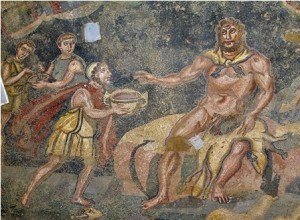Emerging Viruses
If we compare the epidemic of genital condylomatosis with the AIDS one we can find some substantial differences. The HPV epidemic is caused by a virus that has been known for many years and isn’t mortal; the AIDS one is caused by a virus which was previously unknown and the subjects who are affected very often die. HPV is much more stable and may be transferred more easily than HIV.
The causes of the great spreading of genital condylomatosis are sexual promiscuity together with environmental pollution by virus. The latter is caused by the concentration of infected subjects in places that are particularly suitable for the virus survival and spreading.
The causes of HIV emerging have been examined in the previous chapter. Here we are interested in underlining sexual promiscuity is one of them.
Overpopulation and overcrowding can influence both the epidemics either in favouring sexual promiscuity or in allowing viruses to spread.
If we consider the analogies of these three pathologies we realize sexual promiscuity plays an important role in all of them.
It’s, in its turn, strictly linked to overpopulation even when, as in the case of syphilis, we have, above all, to tell about overcrowding (a concentration of more individuals in narrow places where other zones of the territory are scarcely populated).
After establishing the right differences we can see all the three epidemics represent, anyhow, an answer of nature to a human behaviour.
If now we consider, as we already did previously, the great number of different viruses which are present in an animal reserve and the high rate of mutation of viruses that are already well known, we can imagine how many pathogens are ready to compete to conquer the longed, vast market of human population. I am speaking, for example, about Hantaan viruses called like that after the name of the Korean region where they were identified for the first time.
It had been thought for years they might be present also in America so that Carleton Gajdusek, a virologist and Nobel prize, had been able to prove the presence of viruses like Hantaans in a lot of the rodents which had been captured in his estate in Maryland[1].
On following the tradition according to which Hantaan viruses are called after the name of the region where they are identified, the American virologist called his virus Prespect Hill. Yet the microorganism didn’t appreciate such a soft debut and, since he wanted to introduce itself in a right way to American mass media, it chose a film script. The scene takes place in an Indian reserve of the Navayo tribe. The occasion is the funeral of a nineteen year old girl who died because of what seems to be a banal flu.
Her desperate fiancè dies of the same mysterious disease few days after the funeral. Some more deaths follow the first two for a total of thirteen of them. The whole becomes more interesting when it’s suspected for the Prospect Hill virus which had been modified for bacteriological war purposes by the Aymy Medical Research Institute to have caused the epidemic. In a few days the case is known all over America also thanks to the ingredients which make up a story worthy of the best movies.
The mystery is solved thanks to an intuition of Robert Parmenter, a zoologist at New Mexico University. Also this time we find all the usual factors we have seen to be at the origin of many epidemics. First of all there is an animal population (mice) in the phase of their highest numerical increase. The increase of rodent population was caused by heavy rains and plenty of snow which, in usually arid zones, produced an increase of pine-kernels and insects, food for deer mice. Then there is a RNA virus which is endemic in the murine population, but which, thanks to the increase of the latter, can effect the trans-species jump from mice to men. In the new host virulence is such as to cause mortal effects in a short time.
In fact, at first, the symptoms are the ones of a banal flu which, very soon, turns into a serious respiratory syndrome with a pulmonary edema and death.
This virus is called after the name of the zone where the small rodents live: Canyon Muerto. The apparent contradiction of the outbreak of an epidemic in a zone which isn’t densely populated is easily explained with the extraordinary growth of small mice[2]. If such an epidemic had started in a zone at high human density the consequences should have been much more dramatic. In a narrow community the virus spreading occurs in the few possible occasions of aggregation ( in this case a funeral) and stops at the limits of the community itself. This, at least, seemed the most logical explanation.
Then we wondered why the Canyon Muerto virus, which, meanwhile, was renamed Sine Nombre or No Name because the inhabitants of that region had protested, doesn’t cause the disease in every person it infects. The number of individuals who had been affected among the workers in charge of reclaiming the places infested with deer mice is low as well.
Finally it would seem that only 25% of the cases of pulmonary syndrome, which were recorded in the Navayo reserve, may be actually associated with the Hantaan virus; if we paraphrase the story of Ulysses when he was a prisoner of the Cyclops, we could say that nobody( no name) caused the epidemic[3].
Just like HIV also the Sine Nombre virus doesn’t show itself easily and already people are telling about a new,unknown lethal virus.
[1] Gajdusek D C. Virus hemorrhagic fevers. Special reference with renal syndrome epidemic hemorrhagic fever. J Pediatric 60:841-57 1962.
[2] Lee H W, Lee P W and Baek L A. Intraspecific transmission of hantaan vitus, etiologic agent of Korean hemorrhagic fever, in the rodent apodemus agrarious. A M J Trop Med Hyg 30:1106-12. 1981.
[3] In Homer’s Odyssey Ulysses, the protagonist, is captured by a Cyclops, an enormous giant with only one eye and kept prisoner in a cave together with his mates. After being questioned by the Cyclops Ulysses, who is prevident, answers his name is Nobody.
Then the homeric hero, while the giant who is drunk is sleeping, can blind his only one eye and fly away together with his mates clung to the fleece of some sheep. When the Cyclops calls for help, he can’t do but cry: “Nobody has blinded me! “
Ulysses makes Polyphemus drunk
Translated from “Il Virus Intelligente” by Enrica Narducci
To be continued in:
- Emerging Viruses 2°
- Emerging Viruses 3°
- Emerging Viruses 4°
- Emerging Viruses 5°
- Emerging Viruses 6°
About the Author
Written by Ferdinando Gargiulo
Ferdinando Gargiulo offers you a new perspective on why new viral epidemics, assaults, infanticides, suicide epidemics and even environmental catastrophes. Always engaged in his research decides to create a blog to offer his readers content of high value.
Search
Recent Post
Follow on Facebook
Find us on Google Plus
Follow on Twitter
Stories Archive
- Blog (132)
- child labor (10)
- child Prostitution (6)
- Climate Change (20)
- depression (53)
- Depression and suicide (51)
- Environmental catastrophes (22)
- epidemics (44)
- Genetic hypothesis of suicide (47)
- HIV (24)
- Leonardo Da Vinci (8)
- overpopulation (108)
- pedophilia (7)
- Serial Killer (33)
- Suicide Genes (46)
- suicides (56)
- The child as a product (10)
- the intelligent virus (106)
- Uncategorized (59,869)
- Unexplained aggression (36)
- You Tube (6)















